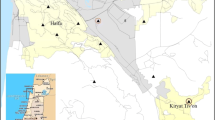Abstract
This paper discusses the role of small area spatial analysis of birth defects in environmental surveillance. Two approaches are reviewed: (1) the investigation of identified geographically localised potential environmental hazards, and (2) the detection of clustering. Examples are given where these 2 types of investigation have been used in the follow-up of individual clusters. Finally, it is argued that environmental surveillance, incorporating the 2 groups of spatial methods, should become a part of public health practice on both proactive and reactive basis.
Similar content being viewed by others
References
Elliott P, Martuzzi M, Shaddick G. Spatial statistical methods in environmental epidemiology: A critique. Stat Med Res 1995; 4: 137–159.
Bithell JF. Statistical methods for analysing point-source exposures. In: Elliott P, Cuzick J, English D, Stern R (eds), Geographical and environmental epidemiology. Oxford: OUP, 1992: 221–230.
Hills M, Alexander F. Statistical methods used in assessing the risk of disease near a source of possible environmental pollution: A review. JR Statist Soc A 1989; 152: 353–363.
Hills M. Some comments on methods for investigating disease risk around a point source. In: Elliott P, Cuzick J, English D, Stern R (eds), Geographical and environmental epidemiology. Oxford: OUP, 1992: 231–237.
Lawson AB, Waller LA. A review of point pattern methods for spatial modelling of events around sources of pollution. Environmetrics 1996; 7: 471–487.
Shaddick G, Elliott P. Use of Stone's method in studies of disease risk around point sources of environmental pollution. Stat Med 1996; 15: 1927–1934.
Stone RA. Investigations of excess environmental risks around putative sources: Statistical problems and a proposed test. Stat Med 1988; 7: 649–660.
Bithell JF, Stone RA. On statistical methods for analysing the geographical distribution of cancer cases near nucelar installations. J Epid Comm Health 1989; 43: 79–85.
Diggle P, Rowlingson B. A conditional approach to point process modelling of elevated risk. Journal of the Royal Statistical Society, Series A 1994; 157: 433–440.
Richardson S. Statistical methods for geographical correlation studies. In: Elliott P, Cuzick J, English D, Stern R (eds), Geographical and environmental epidemiology. Oxford: OUP, 1992: 181–204.
Dolk H, Shaddick G, Walls P, et al. Cancer incidence near radio and television transmitters in Great Britain I. Sutton Coldfield transmitter. Amer J Epid 1997; 145: 1–9.
Dolk H, Elliott P, Shaddick G, et al. Cancer incidence near radio and television transmitters in Great Britain II. All high power transmitters. Amer J Epid 1997; 145: 10–17.
Elliott P, et al. Cancer incidence near municipal incinerators in Britain. Br J Cancer 1996 Mar; 73(5): 702–710.
Dolk H, Vrijheid M, Armstrong B, et al. Risk of congenital anomolies near hazardous-waste landfill sites in Europe: The EUROHAZCON study. Lancet 1998; 352: 423–427.
Croen L, Shaw GM, Sanbonmatsu L, et al. Maternal residential proximity to hazardous waste sites and risk of selected congenital malformations. Epidemiology 1997; 8: 347–354.
Geschwind SA, Stolwijk JAJ, Bracken M, et al. Risk of congenital malformations associated with proximity to hazardous waste sites. Am J Epid 1992; 135: 1197–1207.
Bhopal RS, Phillimore P, Moffat S, Foy C. Is living near a coking works harmful to health? J Epid Comm Health 1994; 48: 237–247.
Lawson AB, Williams FLR. Armadale: A case-study in environmental epidemiology. JR Statist Soc A 1994; 157: 285–298.
Lawson A. On the analysis of mortality events associated with a prespecified fixed point. Journal of the Royal Statistical Society, Series A 1993; 156: 363–377.
Little J, Elwood JM. Epidemiology of anencephalus and spina bifida. Oxford: Oxford University Press, 1992: 456–520.
Morris R, Carstairs V. Which deprivation? A comparison of selected deprivation indices. J Pub Health Med 1991; 13: 318–326.
Dolk H, Mertens B, Kleinschmidt I, et al. A standardisation approach to the control of socioeconomic confounding in small area studies of environment and health. J Epid Comm Health 1995; 49(Suppl 2): S9–S14.
Bithell JF, Dutton SJ, Neary NM, Vincent TJ. Controlling socioeconomic confounding using regression methods. J Epid Comm Health 1995; 49(Suppl 2): S15–S19.
Neutra R. Counterpoint from a cluster buster. Amer J Epid 1990; 132: 1–8.
English D. Geographical epidemiology and ecological studies. In: Elliott P, Cuzick J, English D, Stern R (eds), Geographical and environmental epidemiology. Oxford: OUP, 1992: 3–13.
Alexander FE. Clusters and clustering of childhood cancer: A review. Eur J Epidemiol 1999; 15: 669–674.
Quataert PKM. Statistical methods for cluster studies: Methodological problems and overview. Eur J Epidemiol 1999; 15: 643–653.
Knox EG. Detection of clusters. In: Elliott P (ed), Methodology of enquiries into disease clustering. Proceedings of a meeting held on 22 April 1988 at the London School of Hygiene and Tropical Medicine. London: Small area health Statistics Unit, London School of Hygiene and Tropical Medicine, 1989: 17–20.
Rothman KJ. A sobering start for the cluster busters' conference. Amer J Epid 1990; 132suppl 1: S6–S13.
Niyonsenga T, De Wals P. Methods for the follow-up of clusters of adverse reproductive outcomes. Eur J Epidemiology 1999; 15: 655–659.
Dolk H, Elliott P. Evidence for clusters of anophthalmia is thin. Br Med J 1993; 307: 203.
Dolk H, Busby A, Armstrong BG, Walls PH. Geographical variation in Anophthalmia/Microphthalmia in England 1988–1994: Very little clustering but a higher prevalence in rural areas. Br Med J 1998; 317: 905–910.
Botting B. Limb reduction defects and coastal areas. Lancet 1994; 343: 1033–1034.
Smith D, Neutra R. Approaches to disease cluster investigations in a state health department. Statistics in Medicine 1993; 12: 1757–1762.
Schneider D, Greenberg MR, Donaldson MH, Choi D. Cancer clusters: The importance of monitoring multiple geographic scales. Soc Sci Med 1993; 37: 753–759.
Khoury MJ, Botto L, Mastrioacovo P, Skjaerven R, Castilla E, Erickson JD. Monitoring for multiple malformations: An international perspective. Epidemiol Rev 1994; 16: 335–342.
Czeizel A, Elek C, Gundy S, et al. Environmental trichloroform and cluster of congenital abnormalities. Lancet 1993; 341: 539–542.
Author information
Authors and Affiliations
Rights and permissions
About this article
Cite this article
Dolk, H. The role of the assessment of spatial variation and clustering in environmental surveillance of birth defects. Eur J Epidemiol 15, 839–845 (1999). https://doi.org/10.1023/A:1007569831029
Issue Date:
DOI: https://doi.org/10.1023/A:1007569831029




